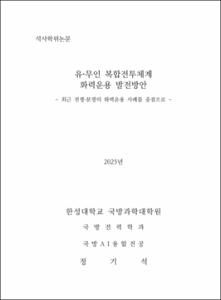유·무인 복합전투체계 화력운용 발전방안
= Development Strategies for Firepower Operations in Unmanned and Manned Hybrid Combat Systems
- Type
- Thesis
- Alternative Title
- 최근 전쟁·분쟁의 화력운용 사례를 중점으로
- Department
- 국방과학대학원 국방전력학과
- Issued Date
- 2025
- Publisher
- 한성대학교 국방과학대학원
- Keyword
- 유-무인 복합전투체계; AI; 공격용드론; High-Low무기체계 배합; 고속 킬러드론; 소형-지능화 및 AI기반 군집드론
- Files in This Item:
-
-
Download
 200000865353.pdf
기타 데이터 / 116.59 MB / Adobe PDF
200000865353.pdf
기타 데이터 / 116.59 MB / Adobe PDF
-
Items in Repository are protected by copyright, with all rights reserved, unless otherwise indicated.